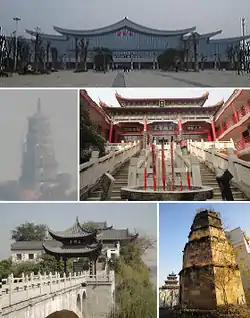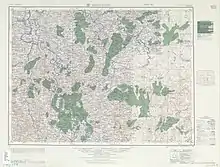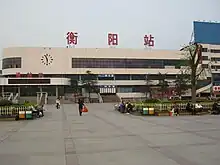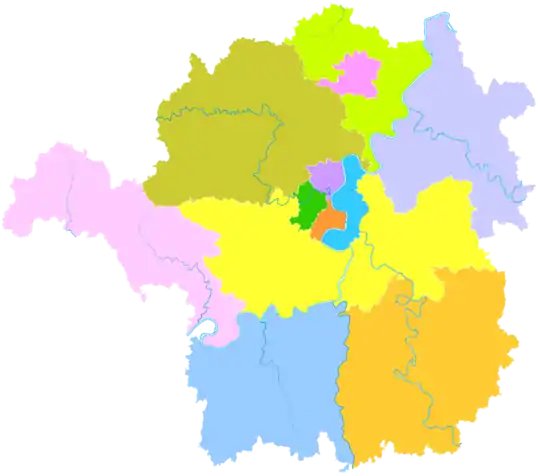Hengyang
Hengyang (simplified Chinese: 衡阳; traditional Chinese: 衡陽; pinyin: Héngyáng; Mandarin pronunciation: [xə̌ŋ.jǎŋ]) is the second largest city of Hunan Province, China. It straddles the Xiang River about 160 km (99 mi) south of the provincial capital of Changsha. As of the 2020 Chinese census, Its total population was 6,645,243 inhabitants, whom 1,290,715 lived in the built-up (or metro) area consisting of 4 urban districts, Nanyue District not being conurbated yet.
Hengyang
衡阳市 Hengchow | |
|---|---|
 From top: Hengyang East Railway Station, Laiyan Pagoda, Dongzhou Island Temple, Shigu Academy, and Dragon Tower | |
| Nickname(s): Wild Goose City (雁城), Bright Pearl in Southern China | |
.png.webp) Location of Hengyang City jurisdiction in Hunan | |
 Hengyang Location of the city center in Hunan | |
| Coordinates (Hengyang government): 26°53′38″N 112°34′19″E | |
| Country | People's Republic of China |
| Province | Hunan |
| Prefecture seat | Yanfeng District |
| Area | |
| • Prefecture-level city | 15,279 km2 (5,899 sq mi) |
| • Urban | 722 km2 (279 sq mi) |
| • Metro | 543 km2 (210 sq mi) |
| Population (2020 census)[1] | |
| • Prefecture-level city | 6,645,243 |
| • Density | 430/km2 (1,100/sq mi) |
| • Urban | 1,361,085 |
| • Urban density | 1,900/km2 (4,900/sq mi) |
| • Metro | 1,290,715 |
| • Metro density | 2,400/km2 (6,200/sq mi) |
| Time zone | UTC+8 (China Standard) |
| Postal code | 421001 |
| Area code | 0734 |
| ISO 3166 code | CN-HN-04 |
| Website | www |
Hengyang is home to University of South China, Hengyang Normal University, and Hunan Institute of Technology, three major provincial public universities in the city.[2]
History
The former name of the city was Hengzhou (Hengchow) (衡州; Héngzhōu[3]). This was the capital of a prefecture in the Tang dynasty's Jiangnan and West Jiangnan circuits. Li Jingxuan was banished to superintendence of Hengzhou after feigning an illness and attempting to usurp control of the legislative bureau at Chang'an against the Gaozong Emperor's wishes in AD 680. Following the AD 705 coup that removed the Empress Wu Zetian from power, her ally Li Jiongxiu was also briefly demoted to superintendence of this province. During the reign of Emperor Muzong, the chancellor Linghu Chu was also demoted to this province for his underlings' alleged corruption.
In the 750s, the superintendent of Hengzhou Chen Xi'ang not only ruled his own region but also used his private army to dominate his nominal superior, the military governor Zhang Weiyi headquartered in Jing Prefecture (modern Jingzhou). Upon Zhang's replacement by the former chancellor Lü Yin in 760, however, Chen was placated and then killed in a surprise attack.
During the reign of the Tang emperor Xizong, Zhou Yue overthrew first the prefect of Hengzhou Xu Hao in 881 and then the agent of the rebel Qin Zongquan in the capital of the Qinhua Circuit at Tan Prefecture (modern Changsha) in 886. Xizong confirmed Zhou Yue in all his posts, renaming his circuit Wu'an. Xizong's brother then gave him additional authority over West Lingnan Circuit (modern Guangxi). Shortly after, in 893, Deng Chune and Lei Man attacked and killed him.
Other superintendents included Qi Ying and Xiao Ye.
After initially falling to agrarian rebels under Yang Shiyuan, Hengzhou was recovered by the lord of Wu'an Ma Yin and formed part of his power base during the collapse of the Tang. He initially supported the Later Liang, then declared himself king (Ma Chu) in his own right during the Five Dynasties and Ten Kingdoms period.
During the Revolt of the Three Feudatories, Wu Sangui declared himself Emperor of the Great Zhou and established an imperial court at Hengzhou in 1678 before dying of illness later that year. His grandson Wu Shifan then retreated to Yunnan, and the Qing recovered Hengzhou the next year.
The Battle of Hengyang was the longest defense of a single city during the Second Sino-Japanese War. When Changsha fell to the Imperial Japanese Army on June 19, 1944, Hengyang became their next target. The reorganized 11th Army, consisting of 10 divisions, four brigades, and over 110,000 men, assumed the task of attacking Hengyang. It was part of the Japanese Ichi-Go offensive.
A Roman Catholic diocese of Hengzhou was established, although periodically suppressed. This was suffragan to the Archbishop of Changsha following its elevation in 1946.
In 2013 Hengyang was the center of a major vote buying scandal where it was found that 56 officials were founded to be complicit in paying lower level local officials for votes. The 56 were subsequently removed from office, and an additional 512 resigned from their positions.[4]
Economy
Hengyang has an area of 15,279 km2 (5,899 sq mi) and a population of 7,141,162. There are 1,075,516 people in the built-up area of 522 km2 (202 sq mi) in the four central urban districts. Hengyang is a busy and growing industrial City and the leading transportation centre of Hunan, linking water, rail, and highway routes. Manufacturing includes: chemicals, agricultural, mining equipment, textiles, paper and processed foods. Lead, zinc, coal, and tin are mined nearby. Hengyang is the second largest city in Hunan province, and is a growing industrial hub and transportation center.
Tourism
Known as the 'Bright Pearl in Southern China' and as 'Wild Goose City' (the latter because of wild geese that used to rest here while flying south for the winter), Hengyang has been the birthplace of many historical figures, such the revolutionist Luo Ronghuan[5] and a noted Ming scholar Wang Fuzhi. The city was badly damaged during World War II[6] and few historical buildings survive in diverse stage of reconstruction, including Shigu Academy, Dragon Tower, Confucian School on the Dongzhou Island (东洲岛), Laiyan Pagoda and Nantai Temple. Mount Heng, one of the Five Sacred Mountains, lies 45 kilometres north from the city proper.
Climate
Hengyang has a humid subtropical climate (Köppen Cfa), with four distinct seasons. Spring is subject to heavy rainfall, while the summers are long, hot, and humid with lesser rainfall, and autumn is comfortable and rather dry. Winter is rather brief, but cold snaps occur with temperatures occasionally dropping below freezing, and while not heavy, rain can be frequent. The monthly daily mean temperature ranges from 6.0 °C (42.8 °F) in January to 29.8 °C (85.6 °F) in July.
| Climate data for Hengyang (1991–2020 normals, extremes 1971–2010) | |||||||||||||
|---|---|---|---|---|---|---|---|---|---|---|---|---|---|
| Month | Jan | Feb | Mar | Apr | May | Jun | Jul | Aug | Sep | Oct | Nov | Dec | Year |
| Record high °C (°F) | 27.7 (81.9) |
32.2 (90.0) |
36.0 (96.8) |
37.0 (98.6) |
37.3 (99.1) |
38.6 (101.5) |
40.2 (104.4) |
41.3 (106.3) |
38.7 (101.7) |
36.5 (97.7) |
32.6 (90.7) |
26.3 (79.3) |
41.3 (106.3) |
| Average high °C (°F) | 9.3 (48.7) |
12.2 (54.0) |
16.4 (61.5) |
23.2 (73.8) |
27.8 (82.0) |
31.0 (87.8) |
34.5 (94.1) |
33.7 (92.7) |
29.7 (85.5) |
24.3 (75.7) |
18.3 (64.9) |
12.2 (54.0) |
22.7 (72.9) |
| Daily mean °C (°F) | 6.4 (43.5) |
8.8 (47.8) |
12.7 (54.9) |
18.8 (65.8) |
23.4 (74.1) |
26.9 (80.4) |
30.0 (86.0) |
29.1 (84.4) |
25.4 (77.7) |
20.1 (68.2) |
14.3 (57.7) |
8.7 (47.7) |
18.7 (65.7) |
| Average low °C (°F) | 4.2 (39.6) |
6.3 (43.3) |
10.0 (50.0) |
15.6 (60.1) |
20.2 (68.4) |
23.9 (75.0) |
26.4 (79.5) |
25.8 (78.4) |
22.2 (72.0) |
16.9 (62.4) |
11.3 (52.3) |
6.0 (42.8) |
15.7 (60.3) |
| Record low °C (°F) | −6.2 (20.8) |
−7.9 (17.8) |
−0.3 (31.5) |
3.7 (38.7) |
10.2 (50.4) |
13.2 (55.8) |
18.9 (66.0) |
18.3 (64.9) |
12.8 (55.0) |
5.4 (41.7) |
−0.7 (30.7) |
−5.9 (21.4) |
−7.9 (17.8) |
| Average precipitation mm (inches) | 81.6 (3.21) |
85.8 (3.38) |
159.0 (6.26) |
150.6 (5.93) |
179.1 (7.05) |
169.0 (6.65) |
119.1 (4.69) |
117.8 (4.64) |
55.0 (2.17) |
62.4 (2.46) |
81.6 (3.21) |
58.8 (2.31) |
1,319.8 (51.96) |
| Average precipitation days (≥ 0.1 mm) | 15.4 | 14.4 | 18.7 | 16.6 | 16.0 | 14.2 | 10.0 | 10.5 | 8.6 | 9.7 | 10.9 | 10.7 | 155.7 |
| Average snowy days | 3.5 | 2.0 | 0.5 | 0 | 0 | 0 | 0 | 0 | 0 | 0 | 0 | 0.9 | 6.9 |
| Average relative humidity (%) | 78 | 77 | 79 | 77 | 76 | 78 | 70 | 72 | 72 | 71 | 73 | 73 | 75 |
| Mean monthly sunshine hours | 57.4 | 58.6 | 73.1 | 101.1 | 130.9 | 137.8 | 232.3 | 197.6 | 152.9 | 130.4 | 112.5 | 96.4 | 1,481 |
| Percent possible sunshine | 17 | 18 | 20 | 26 | 31 | 33 | 55 | 49 | 42 | 37 | 35 | 30 | 33 |
| Source 1: China Meteorological Administration[7][8] | |||||||||||||
| Source 2: Weather China[9] | |||||||||||||
Administrative divisions

The city is divided into the old and new districts. The latter offer citizens and businesses the chance to move from the bleak and polluted city centre to newly constructed housing estates.
- Yanfeng District (雁峰区)
- Zhuhui District (珠晖区)
- Shigu District (石鼓区)
- Zhengxiang District (蒸湘区)
- Nanyue District (南岳区)
- Changning City (常宁市)
- Leiyang City (耒阳市)
- Hengyang County (衡阳县)
- Hengnan County (衡南县)
- Hengshan County (衡山县)
- Hengdong County (衡东县)
- Qidong County (祁东县)
| Map |
|---|
Government
The current CPC Party Secretary of Hengyang is Deng Cequn and the current Mayor is Zhu Jian.
Colleges and universities
This is a list of institutions with full-time bachelor programs in Hengyang:
- University of South China (南华大学)
- Hengyang Normal University (衡阳师范学院)
- Hunan Institute of Technology (湖南工学院)
- Hunan University of Technology Hengyang(湖南工业大学衡阳分校)
Transport


Hengyang is one of the 45 highway hubs in China. G4 Beijing–Hong Kong and Macau Expressway and G72 Quanzhou–Nanning Expressway intersect here. China National Highway 107 (to Beijing, to Guangzhou) and China National Highway 322 (to Kunming) pass the city centre.
Two bus terminals are located in the city. One is Hengyang Western Terminal which is located in the city centre and operates provincial lines and intra-metro lines in northern and western directions. Another is LingHu Terminal which operates lines of southern and eastern directions and locates on the edge of the city.
Hengyang is an important transport hub in southern China. The Beijing–Guangzhou railway and Hunan–Guangxi railway intersect at Hengyang. Hengyang railway station is one of the ten largest railway stations in China and is recognized as one of the extra-premium level stations. More than 100 trains pass by and stop at Hengyang Railway Station, making it one of the busiest stations all over the country and connecting it to most cities of China.
The city's new Hengyang East railway station is served by the Wuhan–Guangzhou high-speed railway and the Huaihua–Shaoyang–Hengyang railway. The Hengyang Metro is a planned monorail rapid transit system.
Opened in 2014, the city is served by Hengyang Nanyue Airport.
Culture
Dialect
Hengyang dialect (Xiang - Lao Xiang湘语-老湘语; Gan赣语; Southwest Mandarin西南官话): the dialects of Hengyang city, Hengyang county and Hennan county are authentic Hengyang local dialects.[10]
intangible cultural heritage
By the end of 2022, Hengyang City has 8 national intangible cultural heritage protection programs and 27 provincial ones.[11]
References
- "China: Húnán (Prefectures, Cities, Districts and Counties) - Population Statistics, Charts and Map".
- "US News Best Global Universities Ranking. Universities in Hengyang". U.S. News & World Report. Archived from the original on June 13, 2022. Retrieved June 13, 2022.
- Larousse Encyclopedie: HENGYANG
- "Lawmakers in Chinese city resign in mass bribery case | Reuters". Reuters.
- Luopan. Hengyang Details Archived 2010-12-15 at the Wayback Machine
- The Australia-China Chamber of Commerce and Industry of New South Wales HUNAN PROVINCE
- 中国气象数据网 – WeatherBk Data (in Simplified Chinese). China Meteorological Administration. Retrieved 11 June 2023.
- 中国气象数据网 (in Simplified Chinese). China Meteorological Administration. Retrieved 28 May 2023.
- 衡阳 - 气象数据 -中国天气网 (in Chinese). Weather China. Retrieved 21 November 2022.
- hu, shunguo (2013-05-21). "衡阳方言" [Hengyang dialect]. Retrieved 2023-10-15.
- "List of Hengyang Municipal, Provincial and National Cultural Relics Protection Units" [衡阳市市级、省级、国家级文物保护单位名录]. 2019-03-27. Retrieved 2023-10-15.
External links
 Hengyang travel guide from Wikivoyage
Hengyang travel guide from Wikivoyage- Official website of Hengyang Government
- Hengyang Information Network
